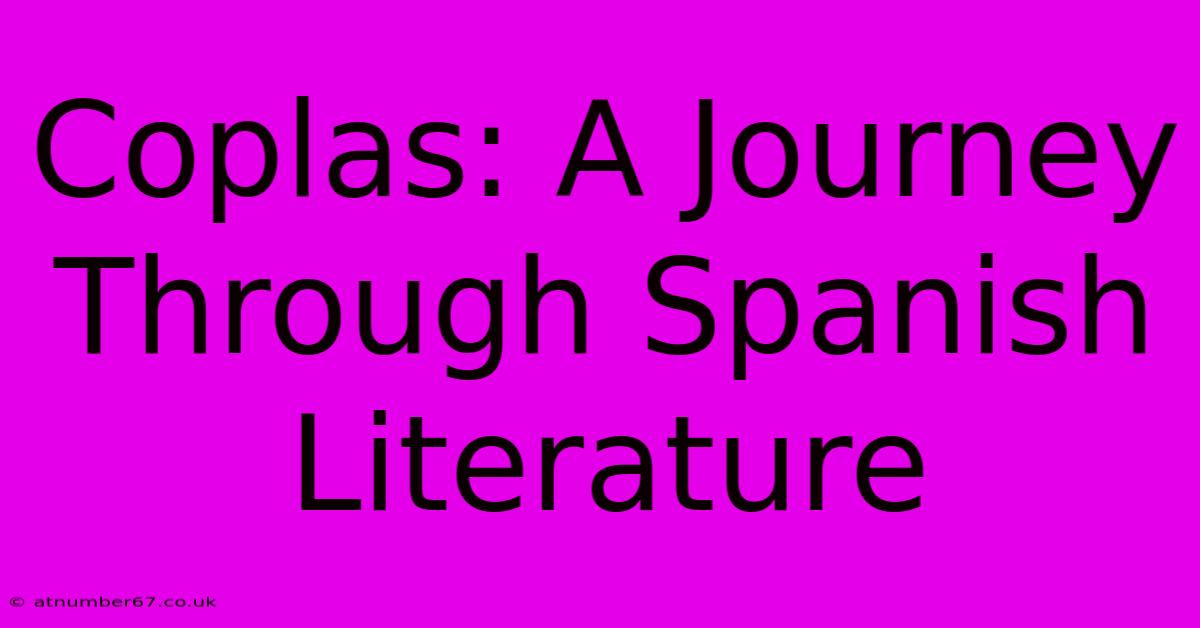Coplas: A Journey Through Spanish Literature

Table of Contents
Coplas: A Journey Through Spanish Literature
The Copla, a seemingly simple verse form, holds a significant place in the rich tapestry of Spanish literature. More than just a rhythmic stanza, the Copla embodies a profound connection to Spanish history, culture, and emotion. This exploration delves into the origins, evolution, and enduring legacy of this poetic form, revealing its multifaceted nature and its enduring appeal across centuries.
Understanding the Copla: Structure and Significance
At its core, the Copla is a short stanza, typically four lines long, characterized by its distinct rhyme scheme and rhythmic structure. While variations exist, the most common form follows an ABAB rhyme scheme, with each line adhering to a specific metrical pattern, often eight syllables per line. This seemingly simple structure, however, belies the depth and complexity it can convey.
Beyond the Structure: Thematic Exploration
The beauty of the Copla lies not solely in its formal qualities but also in its capacity for thematic exploration. From expressing profound grief and lament to celebrating love and joy, the Copla has been a versatile vessel for a wide range of human experiences. Its brevity necessitates conciseness, forcing poets to distill their emotions and thoughts into impactful, memorable lines.
The Copla's versatility
The Copla’s flexibility allows it to adapt to various poetic styles and purposes. It can be found in:
- Traditional folk songs: Often used in ballads and romances, transmitting narratives and cultural beliefs across generations. These oral traditions demonstrate the Copla’s accessibility and enduring presence in everyday Spanish life.
- Religious poetry: Expressing devotion and spiritual reflection, often employed in liturgical contexts.
- Literary works: Used by renowned poets to explore complex themes and emotional landscapes.
Famous Examples and Influential Figures
The history of the Copla is intertwined with the evolution of Spanish literature itself. Several pivotal figures have shaped its development and showcased its expressive power:
Jorge Manrique's Coplas a la muerte de su padre
Arguably the most famous example of the Copla is Jorge Manrique's Coplas a la muerte de su padre (Coplas to the Death of his Father). This poignant elegy, written in the 15th century, transcends mere mourning, offering a profound meditation on mortality, faith, and the fleeting nature of earthly glory. Its enduring popularity speaks volumes about the Copla's ability to touch upon universal human experiences. The poem's impact on subsequent generations of Spanish poets is undeniable.
Other Notable Examples and Influences
While Manrique's work stands as a pinnacle, countless other poets have utilized the Copla to create works of enduring value. Its influence can be traced through various literary movements, showcasing its adaptability and lasting resonance. Exploring these lesser-known examples provides a broader understanding of the Copla's evolution and its diversity of expression.
The Enduring Legacy of the Copla
The Copla's continued presence in Spanish culture testifies to its inherent power and appeal. Beyond its literary significance, it reflects the collective memory and emotional landscape of the Spanish people. Its use in popular songs, traditional celebrations, and contemporary poetry underscores its enduring relevance.
The Copla in Modern Spanish Culture
The Copla remains alive and vibrant in modern Spanish culture. From its use in flamenco music to its continued employment in contemporary poetry, it maintains its capacity to move and inspire. This enduring relevance demonstrates its adaptability and its ability to resonate with audiences across generations.
Conclusion: A Timeless Form
In conclusion, the Copla is far more than a mere poetic structure. It's a window into Spanish history, a mirror reflecting the human condition, and a testament to the enduring power of concise, evocative language. Its journey through centuries of Spanish literature highlights its enduring ability to capture and express the essence of the human experience. Its simplicity belies its depth, proving that the most profound emotions can be conveyed with remarkable brevity and elegance. Its legacy promises to continue inspiring poets and captivating audiences for generations to come.

Thank you for visiting our website wich cover about Coplas: A Journey Through Spanish Literature. We hope the information provided has been useful to you. Feel free to contact us if you have any questions or need further assistance. See you next time and dont miss to bookmark.
Featured Posts
-
Sebastian Dobrincus Net Worth A Detailed Examination
Apr 02, 2025
-
Isabelle Morini Bosc And Her Son A Powerful Connection
Apr 02, 2025
-
Bjoern Borgs Net Worth How He Achieved Financial Success
Apr 02, 2025
-
Lele Pons Age A Surprising Revelation
Apr 02, 2025
-
Margot Robbies Simple Secrets To Happy Family Time
Apr 02, 2025
